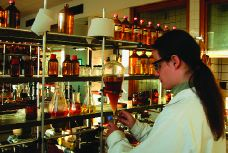Content Navigation
A. MAUREEN ROUHI, C&EN WASHINGTON
A BLIND MAN'S VISION
Young Austrian's passion for chemistry drives him far beyond what his eyes can seeA. MAUREEN ROUHI, C&EN WASHINGTON.
Imagine yourself at breakfast on a weekend, when you have time for fruit juice, cereal and milk, toast with butter and jam, perhaps an egg and a slice of bacon, and a pot of tea. You're sitting down with this spread in front of you. Now close your eyes, and begin to eat. How long will it be before you lose your knife, spill the milk, or scald your hand?
Tschulnigg works in an ordinary laboratory; he has memorized its floor plan.
PHOTO BY MICHAELFor Bernhard Tschulnigg, a blind 24-year-old Austrian, a full breakfast on a weekend is as uneventful as it is for people who can see. All his life, he has managed his blindness so that he can live and realize his ambitions like everyone else.
Born blind, Tschulnigg aspires to be a chemist. In 1998, he began studying for a chemistry degree at Leopold-Franzens University., Innsbruck. In June, he became the first completely blind student in Austria to complete a series of experiments as part of the final exam for an organic chemistry course. Skeptics ask what purpose the feat serves, as Tschulnigg may never work as a bench chemist. Others are moved by his determination to experience chemistry fully.
Tschulnigg's exam consisted of four tasks performed over 20 days. In the first 10 days, last winter, Tschulnigg isolated vanillin from vanilla pods. "This showed us whether Tschulnigg could really work in the lab," says Bernhard Kräutler, a chemistry professor and head of Innsbruck's Institute of Organic Chemistry. "He passed that part very well, and we decided that he should go on to the synthetic work."
In the next 10 days, in June, he performed three syntheses: methylation of vanillin to veratric aldehyde, conversion of veratric aldehyde and malonic acid diethyl ester to ethyl benzalmalonate, and conversion of benzaldehyde and malonic acid to cinnamic acid.
The experiments were chosen to maximize Tschulnigg's use of his other senses, especially smell. "Vanillin has a characteristic smell, and after methylation to veratric aldehyde, the smell is gone," Tschulnigg says. And in the second synthesis, the starting ester has an applelike odor that disappears after the reaction, he notes.
THE LAST SYNTHESISwas especially pleasing odorwise. Benzaldehyde smells like marzipan cookies, Tschulnigg says. "And cinnamic acid smells like cinnamon bark. The lab smelled like Christmas."
Tschulnigg also made much use of touch. For example, he knew that the condensation product of veratric aldehyde and malonic acid diethyl ester is viscous, "because when I shook the flask with the product, I didn't feel the easy splashing of a liquid." Or when preparing a sodium hydroxide solution by adding water to an amount of solid that he had measured and transferred into a flask, "the flask got really hot; I knew that the solids were dissolving."
Jay S. Siegel, a chemistry professor at the University of California, San Diego, was visiting Innsbruck on June 28. Shortly after he arrived, Kräutler invited him to a special event: the last day of the exam, when Tschulnigg was purifying cinnamic acid by recrystallization. The institute had asked members of the faculty and the press and other visitors to observe.
Tschulnigg worked in a regular lab room, with standard glassware, and at regular lab scales, Siegel tells C&EN. "Everything looked normal, save for a very high degree of order. Tschulnigg had burned this lab plan into his mind's eye. Occasionally he would tap the bench to know where he was. He knew how many steps to take to the hood. He was constantly walking about, getting feedback with his hand."
With Tschulnigg were two assistants, chemistry students Andreas Pribil and Wolfgang Wieder. Like spotters in a gymnastics event, they would warn of danger--if, for example, Tschulnigg was about to pour and the receiver wasn't in the right place.
Tschulnigg talked and acted like he saw everything in full color, Siegel recalls. "But then would come the need to decant a hot recrystallization solution and filter the cooled solution with aid of a filter flask fitted with a Buchner funnel, and it was evident that, although Tschulnigg could accomplish the task well, he would never be able to work without assistance."
\Tschulnigg did everything that he could do safely. He collected glassware and equipment from Braille-marked drawers, set up apparatus for operations such as distillation and filtration, dispensed chemicals from Braille-labeled reagent bottles, prepared solutions, and controlled oil-bath temperatures.
Dangerous operations were left to the assistants. For example, methylation of vanillin was to be accomplished with dimethyl sulfate. The extremely hazardous reagent is odorless, and symptoms of intoxication are not immediately apparent, Tschulnigg explains. So when it came time to add dimethyl sulfate through a dropping funnel, Pribil was in charge, with Tschulnigg at a safe distance.
"I have been interested in chemistry since I was six years old," Tschulnigg tells C&EN. He remembers "experimenting" with shampoos and firecrackers. Despite his mother's anxieties, he got a chemistry set when he was nine years old. "I couldn't read the instructions, so my mother had to do the experiments with me," he says. "It was fascinating for me when I was mixing things in my chemistry set and they started cooking. It was like a miracle."
For his elementary schooling, Tschulnigg attended a school for the blind in Innsbruck. When he talked of his desire to be a chemist, "my teachers said it wouldn't be possible," he recalls. He then attended a regular high school in his hometown of Saalfelden. There, "I had a good chemistry teacher who helped me a lot. I became more and more interested in chemistry," he says.
At Innsbruck, Tschulnigg is an "irregular" chemistry major. "In the regular courses, one tries to accommodate for his ability so that he can follow lectures and take notes with his computer," Kräutler tells C&EN. "However, the organic chemistry lab course and exam were designed to his needs, but correspond to what a regular student would do." Regular students take five years to finish the degree. Tschullnig expects he will take at least twice as long.
"For me, chemistry without the practical work is only half chemistry, and half chemistry is no chemistry."
UNTIL THE ORGANICchemistry lab exam, Tschullnig had participated only in lectures, seminars, and written exams. Molecular models, a Braille- and speech-recognition-equipped computer, and hours of study with Pribil and Wieder have made the learning of complex chemistry possible. "With my knowledge and the help of my two assistants, I can describe and imagine how reactions proceed," he says.
After more than three years of lectures and written exams, Tschulnigg began feeling frustrated that he had not done any lab work. "For me, chemistry without the practical work is only half chemistry, and half chemistry is no chemistry," he tells C&EN. He also began to doubt whether he could continue with his studies.
Noting that Tschulnigg did very well in the written organic chemistry exams, "I was strongly convinced that one should make it possible for him to take part in the lab exam," Kräutler tells C&EN. The university would not have expected Tschulnigg to complete a curriculum identical with what regular students take, he adds. But because Tschulnigg is such an avid and determined student, "we wanted to help as best as we can."
It cost about $3,000 to make it possible for Tschulnigg to take the lab exam. The Institute of Organic Chemistry, the dean of studies of the Faculty of Natural Sciences, and the rector of the university "went out of their way to raise the money," Kräutler says.
The lab exam proceeded smoothly: "Nothing broke; I didn't get my hand burned; the institute is still standing," Tschullnig says. But it brought rumblings about the point of a blind student working in a chemistry lab.
Early in the evening of the final day of Tschulnigg's lab exam, members of the faculty gathered at a Nachsitzung--an after-meeting meeting--for beer, snacks, and informal chat. "At one point, the story of Tschulnigg came up and was dismissed by several professors," Siegel recalls. They expressed comments such as: "He will never be able to use this. This is just a publicity stunt for the press."
What Siegel heard is "the usual attitude of many people," Kräutler tells C&EN. "Tschulnigg is an exceptional young person who is determined to be a chemist and happens to have a disability. One should find a way to support someone like him. Think of the alternative--of wasting such talent and enthusiasm for chemistry."
People "have a wrong picture of what I want to do later," Tschulnigg tells C&EN. "I want to go into research, not be a bench chemist. But as a chemist, I need to experience what it's like working in a lab."
Having completed the lab exam in organic chemistry, which he chronicled in a 25-page report, Tschulnigg now is confident he will complete his chemistry studies. He needs to take courses in four other chemistry institutes in Innsbruck, and he is hoping to take part in more lab work. The lab experience will help him overcome the obstacles he may meet as he advances toward his degree, Kräutler believes.
Tschulnigg hopes to do natural products research. He is interested in therapeutic compounds from plants, and he plans to travel to South America next year to learn from indigenous experts. He even dreams of running his own lab where he could, with the help of technicians under his supervision, extract pharmacologically active compounds from natural sources.
"Tschulnigg's biggest educational challenge may be the search for employment," says R. Michael Everly, a legally blind instrumentation scientist at the Jonathan Amy Facility for Chemical Instrumentation at Purdue University. He obtained a B.A. in chemistry from the University of North Florida, Jacksonville, and a Ph.D. from Purdue. Partially sighted, he did not require as much assistance during his chemical education as Tschulnigg does. Everly praises the training he received. "The academic institutions and faculty are accommodating and open-minded. They do a good job of training visually impaired people," he says.
BUT THE CHALLENGESof a job search are different. During job interviews, Everly says, visually impaired people may be asked how much of their work is their own. Safety issues sometimes arise. However, Everly points out, studies show that employees with disabilities have safety records that are equal to or even better than those of their able-bodied coworkers.
Since Everly's job-seeking days, employers have become more welcoming to people with disabilities (C&EN, Nov. 12, 2001, page 55). Resources for those interested in science-related careers have increased, including the American Chemical Society's Committee on Chemists with Disabilities.
Whatever Tschulnigg does with his chemical education, Everly appreciates his desire for lab experience. "Some of your understanding and knowledge comes from what you experience in the lab," he says. "In titration, for example, knowing the mathematics of the end point is very different from experiencing the change due to a big squirt and that due to a small drop. You gain intuition and insight."
During the final day of the lab exam, Siegel says, Tschulnigg "commented on the value of having gotten the feel for reactions and how they are implemented and how he thereby better appreciated the full nature of chemistry as a human pursuit." Watching Tschulnigg do something as simple as recrystallizing cinnamic acid, Siegel tells C&EN, "touched me more deeply than I realized then.
"He said loud and clear through his actions something that I have been trying to convey to students: that chemistry is invaluable for what it lets you see and create in your mind. He is so turned on by the intellectual component that--because he understood the importance of connecting the practical to the intellectual--he wanted the practical experience, blind or not."

